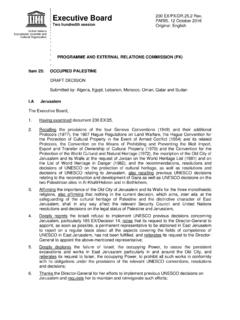Transcription of How will the GCC close the skills gap? - EY
1 How will the GCC close the skills gap?2| How will the GCC close the skills gap?Contents03 Foreword04 Executive summary06 Strategic contextThe drivers of changeThe GCC education landscape10 From education to employmentAddressing the misalignmentFilling the skills gap: four keys to success 27 Conclusion28 Acknowledgments3 How will the GCC close the skills gap? |ForewordThe Gulf region has recognized the importance of education and skills , and are investing heavily in schools, colleges and universities. However, there remains a fundamental misalignment of needs and expectations that makes it hard to improve outcomes. Employers struggle to find the skills they need, especially at entry level. Young people in schools, colleges and universities are unclear about how and why they should enter the job market and build a long-term career.
2 Teachers are unsure about labor market demands and why they should a result, governments are not managing to create the skills and attitudes they need to match the ambition of their national visions, based on increasing the role of the private sector, and promoting entrepreneurship and small and medium-sized businesses. Realigning these needs and expectations will require much closer collaboration between all the players and concrete initiatives to ensure that the generation now coming through school is equipped and motivated to compete in the private sector. This report is based on an in-depth survey we conducted of employers and students across the GCC. We suggest four collaborative approaches to creating an ecosystem of progress from education into employment, and we outline the steps that companies, educators and governments can take to define and then meet their common needs.
3 We hope it inspires ideas and actions that help to prepare the GCC workforce of the CooperPartner and MENA Government Social Infrastructure Leader How will the GCC close the skills gap?One of the primary aims of economic diversification is to create new jobs in the private sector to tackle youth unemployment among nationals in the GCC and ensure sustainable growth. However, if nationals don t have the skills they need to be successful in those jobs, expatriate employees will continue to be the more attractive option for employers. Governments understand that investing in skills , education and training is critical to developing a sustainable local workforce, facilitating rewarding careers for young people and boosting the region s competitiveness.
4 The skills gap, however, is getting bigger not just in the GCC as knowledge economies demand more advanced competences. Collaboration between governments, investors, educators, employers and young people themselves is critical to creating a supportive ecosystem to preparing young people to contribute to the GCC workforce of the future. To increase youth employability, governments need to address obstacles in the progression from education to employment, investing not only in education and preparation for employment, but also in education about opportunities in the 21st-century labor market. Initiatives must be driven by the needs of employers, with all levels of the education system involved in meeting these needs early in the life cycle of a student.
5 We have identified four key areas for attention:Aligning curricula with employers needs Providing information about careersDeveloping the workforce through experience and trainingEncouraging a culture of employment, innovation and entrepreneurshipExecutive summary5 How will the GCC close the skills gap? |Executive summaryNext stepsFor the private sector: engagement Get involved in schools, colleges and universities, talking to students, providing advice and forming partnerships to help develop curricula and work experience schemes Collaborate within sectors to develop a clear, consistent set of needs to discuss with schools and the government, defining the technical and soft skills , as well as the behaviors and attitudes, that a graduate needs to have for you to hire them Invest and sign up to job training, work placements and internships.
6 Support or create apprenticeships, creating fast-track schemes for participating studentsFor the education sector: execution Invest in a clear picture of the future business landscape to ensure that the national educational infrastructure is designed to fit the national job profile of the future Focus on raising teacher training quality and introducing new approaches and techniques to teaching Adapt the curricula, developing a balance of practical skills and academic understanding that is relevant to the current and future job market, and integrating work experience Enhance curricular and extra-curricular opportunities to develop enterprise skills and mindset Engage with parents and guardians to support young people s career decisions For the government.
7 Enablement Mandate and push through educational initiatives with a clear strategy and focus Provide incentives to the private sector to get more involved; for example, through apprenticeships and graduate training schemes Ensure that incentives are not distorted further by considering equalizing public sector pay with that of private sector benchmarks Get the message out to young people that employment in the private sector is rewarding Invest in promoting the merits of entrepreneurship and establishing a business6| How will the GCC close the skills gap?Strategic context6| How will the GCC close the skills gap?7 How will the GCC close the skills gap? |The drivers of changeThere is an urgent need to get more GCC nationals working in the private sector.
8 The old model of employing nationals in high-paying government jobs is no longer sustainable. It is damaging for the public sector: budgets are strained and government businesses struggle to become more efficient. It is damaging for the private sector too, which relies heavily on expatriates for its workforce. In the UAE and Qatar, only 1% of the private sector workforce is made up of nationals, rising to a high of just 18% in Saudi If the GCC is to employ the fast-growing number of young nationals entering the labor market and remain competitive, it needs to create more jobs in the private sector but just as importantly, it must ensure that nationals have both the motivation and the skills to fill them. Governments around the world are facing growing skills gaps the dual challenges of high youth unemployment levels alongside a severe lack of required skills .
9 In the GCC, the problem is particularly urgent for two reasons. Firstly, youth unemployment is already among the highest in the world, boosted by the fast-growing population. Saudi Arabia has the highest rate in the GCC at 30%, according to figures from the International Labor Organization (ILO). Even in the UAE, where per capita income is high and the national population relatively small, the rate has reached 10% and the trend is upward (see Figure 1).Figure 1. Youth unemployment, ILO projections for 2014 and 2018 (%)KSAB ahrainOmanKuwaitUAEQ atar303129312126191610122320182014 Secondly, the social and financial incentives provided for nationals to take secure and well-paying public sector jobs have reduced the motivation to develop private sector skills and the experience that would help develop them.
10 Our survey of 1,000 students and 100 employers across the GCC (see Survey methodology , page 27) shows that, outside of Bahrain, GCC students show an overwhelming preference for public sector jobs. This mindset has to change to stop the unemployment rate escalating in the medium to long term, and to enable the successful diversification of the economy away from dependence on oil and gas International Monetary Fund estimates that, if the current share of nationals in the private sector remains as it is now, as many as million nationals could enter the labor market in 2018, with only 600,000 private sector jobs generated to accommodate As the events of the Arab Spring demonstrate, failure to tackle youth unemployment risks, unrest and political and economic reorient young nationals toward private sector employment.


















